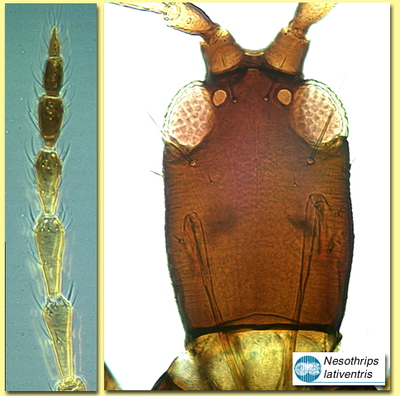Species
Nesothrips lativentris KarnyFigures
Fig. 1 Antenna and head (dorsal)Fig. 2 PronotumFig. 3 Tergite III and IV with wing retaining setaeFig. 4 Fore and hind wing
Biology
Adults and larvae of this spore-feeding species are commonly found on the dead fronds of coconut palms, but can also be found sometimes on dead branches.
Distribution
Widespread around the tropics, but probably originating from the western Pacific.
Recognition
A large dark thrips with antennal segment III and most of IV and all tarsi yellow; forewing, when present, pale with base weakly shaded. Antennae 8-segmented, segment III with 2 sense cones, IV with 4 sense cones; III slender and slightly longer than IV. Head longer than wide, projecting slightly in front of eyes; maxillary stylets broad, retracted nearly to postocular setae, wide apart and V-shaped in head; postocular setae extending beyond anterior margin of eyes; one pair of prominent setae arising close together between posterior ocelli. Pronotum with 5 pairs of major setae, the 2 anterior pairs much shorter than the posterior pairs. Female fore tarsus without tooth. Forewing parallel-sided; distal posterior margin with 10 to 15 duplicated cilia. Tergites II-VII each with one pair of sigmoid wing-retaining setae; tergite IX major setae about as long as tube. Male with large fore tarsal tooth; large male with fore femora swollen and L-shaped.
Related species
This genus includes about 25 species, mostly from the Western Pacific, including New Zealand and Australia, but most of these have the head wider than long, and few of them have a pair of setae arising close together between the posterior pair of ocelli.





